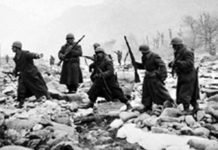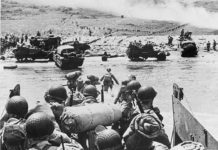Saragarhi is located in Waziristan, which is now part of Pakistan. The entire region is mountainous and is part of the tribal belt known as the North West Frontier Province. This area is home to restive Moslem tribes who have rarely accepted rule from Delhi. In a bid to control this tribal belt the English had renovated certain forts originally built by Raja Ranjeet Singh, to keep a check on these tribes through force of arms.
Saragarhi was a heliographic communication post that facilitated messages and communication between two forts at Gulistan and Lockart which were out of the line of sight of each other.
The Battle of Saragarhi
In 1897 the tribes had risen in revolt against British rule and accordingly the British had dispatched troops to quell the uprising. Both the forts were manned and the Heliographic unit at Fort Saragrahi was also activated. It was manned by 21 Sikh soldiers of the 36 Regiment. The troops were led by Havildar Ishwar Singh, an upright officer who was steeped in loyalty to the Raj.
The tribal hordes moved all over the hills and decided to attack Sargarhi on 12 Sep 1897. The tribal commander Gul Shah reasoned that in case the post at Saragarhi was captured, it would be easier to capture the two British forts. Accordingly on 12Sept 1897 a Moslem tribal force of 10,000 under Gul Shah attacked the fort. Lt Col Haughton the commander in the Fort at Lockhart was apprised of the attack.
Col Haughton ordered a relief column but as the fort was itself surrounded the relief column could not make much headway. However the course of the battle was signaled to the forts at each and every step by the signaler Sepoy Gurmukh Singh .
The battle raged for 6 hours and it is estimated that the Moslems suffered over 1000 dead. Sepoy Gurmukh Singh continued doing his duty of informing his CO of the state of the battle, till he was the last man left. He then requested permission to stop signaling and be the last martyr. Permission was granted and thus Sepoy Gurmukh Singh died fighting the Moslem Horde.
Honoring the Sikhs of 36 Regiment
The bravery of the 21 Sikhs had an echo in the British parliament when in 1898 all the MP’s stood up as a mark of respect to the memory of the 21 Sikh soldiers. The Indian order of merit which is equivalent to the Victoria Cross was awarded to all the Sikhs. The British also gave generous donations in land and cash to all the next of kin of the soldiers who had died.
Most of the Sikhs who died that day were from Ferozpur and the British built a gurudwara in their memory there. The day 12 Sept is remembered as Raising day by the Sikh regiments in Indian Army. It certainly invites comparison with Thermopylae where a force of 300 Spartans faced vast numbers of Persians. This battle is a classic page in the history of the Indian Army.
Source:
- Saragarhi Battalion:Ashes to Glory by Kanwaljit Singh and H.S. Ahluwalia, New Delhi : Lancer International, 1987








